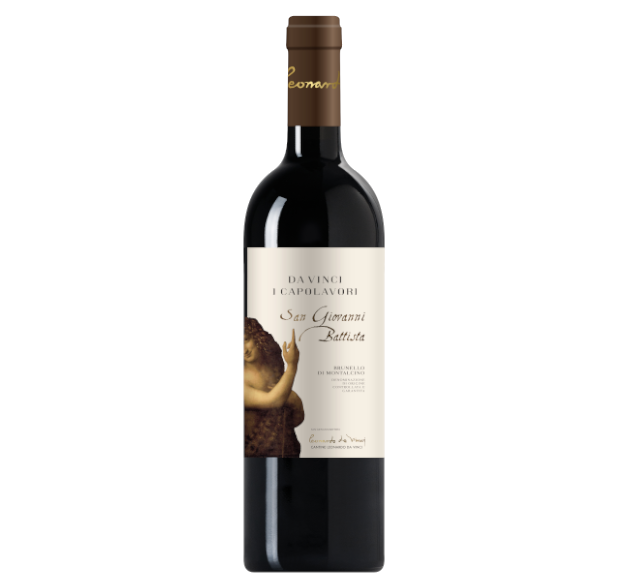DA VINCI I CAPOLAVORI SAN GIOVANNI BATTISTA 2018 - Brunello di Montalcino - Tuscany - Italy
DA VINCI I CAPOLAVORI SAN GIOVANNI BATTISTA - Brunello di Montalcino - Tuscany - Italy
Intense fruity hints of blackberries, blackcurrants and cherries on the nose. Full-bodied and rich with a soft fruitiness that is congruous with aromas on the nose. Well-balanced with a good freshness.
 ITALY
ITALY
Product Description
Description
Purple red in color wiht garnet hues. Intense fruity hints of blackberries, blackcurrants and cherries on the nose. Full-bodied and rich with a soft fruitiness that is congruous with aromas on the nose. Well-balanced with a good freshness.
How to pair it
-
 Meat
Enjoy with game, red meat
Meat
Enjoy with game, red meat
-
 Cheese
Enjoy with cheese
Cheese
Enjoy with cheese
Accolades
Awards

James Suckling 94 Points
As one of the most famous American wine critics and journalists, James Suckling is among the leading experts on wines and was a former editor for Wine Spectator. He now conducts his own personal reviews online and conferences
Critique Review

“Black cherry, spice and slate with some graphite. Dark chocolate and vanilla undertones. Medium to full body. Spicy and flavorful. Fascinating young Brunello. Drink in 3 or 4 years”
94 pts, James SucklingWine Facts
| Product Type | Red Wine |
|---|---|
| Vintage | 2018 |
| Country | ITALY |
| Volume(ml) | 750 |
| Winemakers | Head winemaker: Riccardo Pucci |
| Producer | Leonardo da Vinci SpA |
| Average age of vines | 20 years |
| Harvest method | Hand-harvest |
| Fermentation & maceration | Red vinification with maceration on the skins for 20-25 days, with frequent stirring at a controlled temperature of up to 24°C |
| Aging | The wine spends at least 30 months in 50 Hl Slavonian oak barrels. The wine rests in the bottle for at least 6 months. |
| Alcohol | 13.5% |
| SKU | IT191 |
Vineyard Info
"The Montalcino hill has numerous pedological environments as it was formed in different geological eras, mainly a clayey mixture rich in shells. The presence on the territory of slopes with different orientations, the marked modulation of the hills and the difference in altitude between valley areas and the highest territory, determines very different climatic microenvironments, even in areas very close to each other. The quality of Brunello di Montalcino is born in the vineyard, thanks to meticulous manual work, from the dry pruning to the choice of the most suitable bud, from the containment of the vegetation to the thinning of the bunches, operations aimed at producing and selecting the best fruits."
Reviews & Ratings
Description
Purple red in color wiht garnet hues. Intense fruity hints of blackberries, blackcurrants and cherries on the nose. Full-bodied and rich with a soft fruitiness that is congruous with aromas on the nose. Well-balanced with a good freshness.
How to pair it
-
 Meat
Enjoy with game, red meat
Meat
Enjoy with game, red meat
-
 Cheese
Enjoy with cheese
Cheese
Enjoy with cheese
Awards

James Suckling 94 Points
As one of the most famous American wine critics and journalists, James Suckling is among the leading experts on wines and was a former editor for Wine Spectator. He now conducts his own personal reviews online and conferences
Critique Review

“Black cherry, spice and slate with some graphite. Dark chocolate and vanilla undertones. Medium to full body. Spicy and flavorful. Fascinating young Brunello. Drink in 3 or 4 years”
94 pts, James Suckling| Product Type | Red Wine |
|---|---|
| Vintage | 2018 |
| Country | ITALY |
| Volume(ml) | 750 |
| Winemakers | Head winemaker: Riccardo Pucci |
| Producer | Leonardo da Vinci SpA |
| Average age of vines | 20 years |
| Harvest method | Hand-harvest |
| Fermentation & maceration | Red vinification with maceration on the skins for 20-25 days, with frequent stirring at a controlled temperature of up to 24°C |
| Aging | The wine spends at least 30 months in 50 Hl Slavonian oak barrels. The wine rests in the bottle for at least 6 months. |
| Alcohol | 13.5% |
| SKU | IT191 |
"The Montalcino hill has numerous pedological environments as it was formed in different geological eras, mainly a clayey mixture rich in shells. The presence on the territory of slopes with different orientations, the marked modulation of the hills and the difference in altitude between valley areas and the highest territory, determines very different climatic microenvironments, even in areas very close to each other. The quality of Brunello di Montalcino is born in the vineyard, thanks to meticulous manual work, from the dry pruning to the choice of the most suitable bud, from the containment of the vegetation to the thinning of the bunches, operations aimed at producing and selecting the best fruits."
